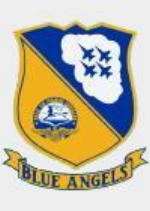Hobby Master HA7204 US Navy Grumman F9F Panther Fighter - Lieutenant Commander R. E. "Dusty" Rhodes, Team Leader of the "Blue Angels", 1949 (1:48 Scale)
" [The US] Navy Flight Exhibition Team thrilled spectators with low-flying maneuvers performed in tight formations, and (according to Voris) by "...keeping something in front of the crowds at all times. My objective was to beat the Army Air Corps. If we did that, we'd get all the other side issues. I felt that if we weren't the best, it would be my naval career."
- Lieutenant Commander Roy Marlin "Butch" Voris, a World War II fighter ace, named Officer-in-Charge and Flight Leader of the US Navy's first flight demonstration squadron
 The Grumman F9F Panther was the manufacturer's first jet fighter and the U.S. Navy's second. The Panther was the most widely used U.S. Navy jet fighter of the Korean War. It flew 78,000 sorties and was responsible for the first air kill by the US Navy in the war - the downing of a North Korean Yakovlev Yak-9 fighter. Total F9F production was 1,382, with several variants being shipped to Argentina for export.
The Grumman F9F Panther was the manufacturer's first jet fighter and the U.S. Navy's second. The Panther was the most widely used U.S. Navy jet fighter of the Korean War. It flew 78,000 sorties and was responsible for the first air kill by the US Navy in the war - the downing of a North Korean Yakovlev Yak-9 fighter. Total F9F production was 1,382, with several variants being shipped to Argentina for export.
Development studies at the Grumman company began near the end of the World War II as the first jet engines emerged. The prototype Panther, piloted by test pilot Corky Meyer, first flew on November 24th, 1947. Propulsion was a Rolls-Royce Nene turbojet built under license by Pratt & Whitney as the J42. Since there was insufficient space within the wings and fuselage for fuel for the thirsty jet, permanently-mounted wingtip fuel tanks were added which incidentally improved the fighter's rate of roll. It was cleared for flight from aircraft carriers in September 1949. During the development phase, Grumman decided to change the Panther's engine, selecting the Pratt & Whitney J48-P-2, a license built version of the Rolls-Royce Tay. The other engine that had been tested was the Allison J33-A-16, a development of the Rolls-Royce Derwent.
From 1946, a swept-wing version was considered and after concerns about the Panther's inferiority to its MiG opponents in Korea, a conversion of the Panther (Design 93) resulted in a swept-wing derivative of the Panther, the Grumman F9F Cougar, which retained the Panther's designation number.
Pictured here is a 1:48 scale diecast replica of a US Navy Grumman F9F Panther fighter that was piloted by Lieutenant Commander R. E. "Dusty" Rhodes, Team Leader of the "Blue Angels" during 1949. Only 1,200 pieces produced.
Sold Out!
Dimensions:
Wingspan: 9-1/2-inches
Length: 9-3/4-inches
Release Date: November 2008
Historical Account: "Precision Flying" - The United States Navy's Navy Flight Demonstration Squadron, popularly known as the Blue Angels, was formed in 1946 and is the world's first officially sanctioned military aerial demonstration team.
The Blue Angels first flew three aircraft in formation, then four, and currently operate six aircraft per show. A seventh aircraft is for backup, in the event of mechanical problems with one of the other aircraft, and for giving public relations "demonstration flights" to civilians, usually selected from a press pool.
This aerobatic team is split into "the Diamond" (Blue Angels 1 through 4) and the Opposing Solos (Blue Angels 5 and 6). Most of their displays alternate between maneuvers performed by the Diamond and those performed by the Solos.
The Diamond, in tight formation and usually at lower speeds, performs maneuvers such as formation loops, barrel rolls, or transitions from one formation to another.
The Opposing Solos usually perform maneuvers just under the speed of sound which showcase the capabilities of their individual F/A-18 Hornets through the execution of high-speed passes, slow passes, fast rolls, slow rolls, and very tight turns. Some of the maneuvers include both solo F/A-18s performing at once, such as opposing passes (toward each other in what appears to be a collision course, narrowly missing one another) and mirror formations (back-to-back. belly-to-belly, or wingtip-to-wingtip, with one jet flying inverted).
At the end of the routine, all six aircraft join in the Delta formation. After a series of flat passes, turns, loops, and rolls performed in this formation, they execute the team's signature "fleur-de-lis" closing maneuver.
The parameters of each show must be tailored to local visibility: In clear weather the "high" show is performed, in overcast conditions it's the "low" show that the spectators see, and in limited visibility (weather permitting) the "flat" show is presented. The "high" show requires an 8,000-foot (2,400 m) ceiling and visibility of 3 nautical miles (6 km) from the show's centerpoint. "Low" and "flat" ceilings are 3,500 and 1,500 feet (460 m) respectively. (courtesy: Wikipedia)


